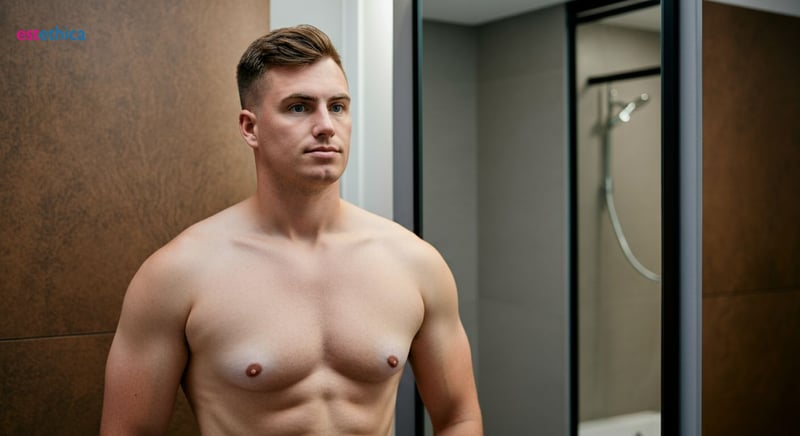Gynecomastia: Beyond Man Boobs – Understanding & Solutions
Discover effective solutions and understanding of gynecomastia, the causes, and treatments to regain confidence and enhance well-being.
Gynecomastia, often colloquially referred to as 'man boobs', is a condition that affects many men worldwide. While it can cause discomfort and self-esteem issues, understanding this condition's nature and available solutions is crucial. This article dives into the distinctions between gynecomastia and pseudogynecomastia, explores potential causes, and examines both surgical and non-surgical treatment options, including the role of weightlifting in management.
Gynecomastia vs. Pseudogynecomastia: Decoding Enlarged Male Breasts
Differentiating Gynecomastia and Pseudogynecomastia
Gynecomastia and pseudogynecomastia are both conditions that result in enlarged male breasts, but they stem from different origins. Gynecomastia involves the enlargement of glandular breast tissue due to hormonal imbalances, typically an increase in estrogen or a decrease in testosterone levels. On the other hand, pseudogynecomastia is characterized by fat deposition rather than glandular tissue and is often related to weight gain or obesity. While both conditions may appear similar from a physical standpoint, understanding their differences is key to determining the appropriate treatment path. In cases where gynecomastia is due to hormonal imbalances, medical treatment to address these hormonal levels may be necessary. In contrast, pseudogynecomastia can often be managed with diet and exercise aimed at reducing body fat.
Key Differences Between Gynecomastia and Pseudogynecomastia
- Tissue Composition: Gynecomastia involves the growth of glandular breast tissue, whereas pseudogynecomastia is due to the accumulation of fat.
- Hormonal Influence: Gynecomastia is typically linked to hormonal imbalances, such as an increase in estrogen or a decrease in testosterone, impacting the mammary glands.
- Primary Cause: Gynecomastia often arises from hormonal changes, medication side effects, or underlying health conditions; pseudogynecomastia is usually associated with excess body fat.
Diagnosing these conditions typically involves a physical exam, medical history review, and possibly blood tests to check hormone levels. An estimated 40-60% of adolescent males may experience some degree of gynecomastia during puberty, highlighting the importance of proper diagnosis and management.
Treatment Approaches for Each Condition
- Medical Intervention for Gynecomastia: Treatment may include medications like selective estrogen receptor modulators (SERMs) to balance hormone levels.
- Lifestyle Modifications for Pseudogynecomastia: A balanced diet and regular exercise can reduce overall body fat, mitigating the appearance of enlarged breasts.
- Surgical Options: In some cases, surgical intervention, such as liposuction or excision of glandular tissue, may be considered for both conditions based on severity and patient preferences.
Understanding the specific approach to managing enlarged male breasts begins with a thorough evaluation to determine whether the condition is due to glandular proliferation or fat deposition. Consulting with a healthcare professional ensures a personalized and effective treatment strategy.

What Causes Gynecomastia? Exploring the Root of the Issue
The Role of Hormonal Imbalance in Gynecomastia
Hormonal imbalances are frequently implicated in the development of gynecomastia. This condition occurs when there is a disproportionate level of estrogen compared to testosterone in a male's body. Estrogen stimulates the growth of breast tissue, while testosterone inhibits it. Certain medical conditions, such as Klinefelter syndrome and testicular tumors, can lead to increased estrogen production, resulting in gynecomastia. For instance, an imbalance could also arise during puberty, when hormone levels fluctuate considerably. Moreover, as men age, testosterone levels naturally decline, creating a hormonal environment more conducive to breast tissue growth.
Factors Contributing to Gynecomastia Development
- Medications: Certain drugs, like anti-androgens, anabolic steroids, and some antidepressants, can disrupt the hormonal balance.
- Medical Conditions: Diseases affecting the testes, pituitary gland, or liver can alter hormone production, increasing the risk of gynecomastia.
- Lifestyle Choices: Excessive alcohol consumption and recreational drug use can impair liver function and affect the body's ability to regulate hormone levels.
Correct diagnosis requires a complete evaluation of medical history and lifestyle to ascertain which of these factors contributes most heavily to the onset of gynecomastia. Understanding the specific triggers help doctors tailor more effective treatment plans for each individual.
Steps in Diagnosing the Cause of Gynecomastia
- Medical History Review: Detailed examination of past illnesses, medications, and family history to identify potential risk factors.
- Physical Examination: Thorough assessment of breast tissue and overall physical health to rule out other conditions, like tumors or infections.
- Hormone Level Testing: Blood tests to measure levels of testosterone, estrogen, and other relevant hormones, essential to pinpoint hormonal imbalances responsible for the condition.
It's estimated that about 25% of gynecomastia cases in adult men are caused by medication side effects. This underscores the importance of reviewing one's medications with a healthcare provider. Proper diagnosis not only clarifies the immediate cause of gynecomastia but also guides long-term management strategies, paving the way for effective treatment and improved quality of life.

Male Breast Reduction: Surgical and Non-Surgical Treatment Options
Weighing Surgical Options for Gynecomastia
Surgical intervention for gynecomastia typically involves procedures tailored to address the underlying causes of enlarged male breasts. Liposuction is frequently used to remove excess fat, particularly in cases of pseudogynecomastia, where fat accumulation is the primary concern. Glandular tissue removal, or mastectomy, becomes necessary when gynecomastia is primarily due to hormonal imbalances. These surgeries, often conducted by specialists, aim to deliver significant and long-lasting improvements. For instance, during puberty, around 50% of adolescent males may experience gynecomastia, and surgery can provide a resolution when the condition persists. The results are often permanent, and the procedures are precise, with dedicated specialists ensuring the most effective solution based on individual needs and conditions. Considering that up to 70% of men may experience gynecomastia at some point in their lives, surgical options offer a viable path to improved physical and emotional well-being.
Exploring Non-Surgical Alternatives
- Lifestyle Adjustments: Embracing a balanced diet and regular exercise can significantly reduce fat, particularly beneficial in cases of pseudogynecomastia.
- Hormonal Therapy: Medications that balance hormone levels, may address underlying hormonal imbalances contributing to glandular breast tissue growth in gynecomastia.
- Observation: Cases of mild gynecomastia, especially during puberty, often resolve naturally with time.

Gynecomastia and Weightlifting: Is Exercise the Answer?
The Role of Weightlifting in Managing Gynecomastia
Exercise, notably weightlifting, is frequently recommended as a part of managing gynecomastia, particularly for pseudogynecomastia patients. While exercise can effectively reduce overall body fat and improve muscle tone, it may not specifically target glandular tissue associated with true gynecomastia. Weightlifting can help individuals enhance chest muscle definition, which might improve the appearance of the chest but won’t typically eliminate breast tissue due to hormonal imbalances. It is, however, an excellent supportive treatment alongside medical or surgical interventions. Regular exercise also brings numerous health benefits including improved cardiovascular health and increased confidence, which can be particularly beneficial for those struggling with body image issues related to gynecomastia. Did you know that incorporating weightlifting into a fitness routine can increase testosterone levels, potentially offsetting the hormonal imbalance seen in true gynecomastia? Weightlifting serves as a great complement to medical treatments as a way to physically improve the physique.
Benefits of Weightlifting for Chest Appearance
- Improved Muscle Definition: Weightlifting enhances the pectoral muscles, creating a firmer and more defined chest, which reduces the visibility of enlarged breasts.
- Fat Reduction: Consistent weightlifting, combined with cardiovascular exercises, helps burn overall body fat, which is beneficial for pseudogynecomastia.
- Enhanced Body Image: Strengthening the chest muscles improves the overall physique, boosting self-esteem and body confidence.
Weightlifting is one of the easiest lifestyle changes to make that can have long-term effects on your physique and health. Talk to gynecomastia experts at estethica Global to understand your physiology and what options are best for you.
Integrating Weightlifting Into a Gynecomastia Management Plan
- Assess the Condition: Determine whether the gynecomastia is true gynecomastia or pseudogynecomastia through a thorough medical evaluation.
- Develop a Targeted Workout Plan: Focus on exercises that strengthen and define the pectoral muscles, such as bench presses, dumbbell flyes, and push-ups. Combine with cardio to reduce overall body fat.
- Monitor Progress and Adjust: Regularly assess the impact of exercise on chest appearance and overall health, adjusting the workout plan as needed.
Weightlifting, when combined with a healthy diet, is a powerful tool for improving chest appearance and the overall physique, particularly in conjunction with professional medical advice from estethica Global. Such integration can lead to better physical health and increased self-esteem.
Comprehensive Male Breast Reduction Expertise at estethica: Distinguishing Gynecomastia and Optimizing Treatment Strategies
estethica provides specialized expertise in distinguishing between gynecomastia and pseudogynecomastia, ensuring accurate diagnoses through physical exams, medical history reviews, and hormone level testing. The clinic tailors treatment plans based on the root cause, offering medical interventions like SERMs for hormonal imbalances and recommending lifestyle modifications for fat reduction in pseudogynecomastia cases. Surgical options, including liposuction and glandular tissue excision, are available for more severe cases, providing personalized and effective solutions.
estethica’s commitment to patient safety and health is documented through international awards and certificates. Its expert physician staff and experienced healthcare personnel ensure patients receive the highest quality care in male breast reduction. The clinic uses advanced techniques, such as liposuction and glandular tissue removal, to address the specific needs of each patient, guided by a forward-thinking and innovative approach to medical care.
estethica Ensures Excellence in Gynecomastia Treatment Processes
estethica prioritizes patient comfort and safety by providing comprehensive pre- and post-operative care, personalized treatment plans, and detailed consultations. The clinic fosters a transparent and accessible healthcare environment, ensuring patients are well-informed and supported throughout their treatment journey. estethica follows strict quality management protocols and uses advanced technology to minimize errors and maximize patient satisfaction, prioritizing ethical values and patient well-being.
Many patients have benefited from estethica's approach to gynecomastia treatment, with improvements in their physical appearance, self-esteem, and overall quality of life. By combining lifestyle adjustments, hormonal therapies, and surgical interventions, estethica helps patients address their gynecomastia concerns effectively. Comprehensive post-operative support and care, contribute to high satisfaction rates among patients seeking male breast reduction solutions.
Frequently Asked Questions
What is the difference between gynecomastia and pseudogynecomastia?
What are the primary causes of gynecomastia?
Can weightlifting help in managing man boobs (gynecomastia)?
What are the surgical treatment options for male breast reduction?
Are there non-surgical treatments for gynecomastia?
Achieve your aesthetic goals with estethica's personalized treatment plans and expert care.
📞 Book Your Free Consultation!